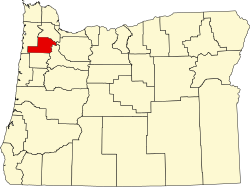Wheatland | |
|---|---|
 Wheatland | |
| Coordinates: 45°05′33″N123°03′00″W / 45.09250°N 123.05000°W | |
| Country | United States |
| State | Oregon |
| County | Yamhill |
| Elevation | 118 ft (36 m) |
| Time zone | UTC-8 (Pacific (PST)) |
| • Summer (DST) | UTC-7 (PDT) |
| GNIS feature ID | 1136896 [1] |
Wheatland is an unincorporated community in Yamhill County, Oregon, United States. It is near the Willamette River where the Wheatland Ferry takes traffic across the river into Marion County. It is in the Pacific Time Zone.


